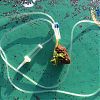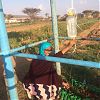Use of locally available material to improve efficiency of water use

4 April 2017 - An interesting analysis by Amina Abdi Ali - Year 2, Bachelor of Science program student at ISTVS
The effect of drought in Somaliland seems to be getting worse year after year. There is, therefore, an urgent need to develop sustainable mitigation and adaptation measures with an effort to curb this menace. Tree planting is one of the mitigation measures to drought especially in drylands such as the Somali ecosystem where vegetation cover is often low. Despite the benefits associated with trees, only a handful of people have embraced the practice of tree planting. Lack of irrigation water coupled with unreliable and unpredictable rainfall could be a major reason for the low levels of tree planting in the region.
As an agriculture student studying Bachelor of Science in dry land economics and agro system management accredited by the University of Nairobi, I’m harnessing the knowledge and skills acquired during my courses to device sustainable means to water use efficiency in the school tree nursery. Previously, watering has been done by use of buckets; this has been both wasteful and exposed the seedlings to physical injuries. The simple innovation discussed in this article is therefore aimed at ensuring that water being a scarce resource in the Somali ecosystem is used efficiently in tree nurseries.
Using locally available recycled material, a device can be made as a means of irrigation for the nursery. In this case, I’m using a drip pipe and a water bottle to regulate the amount of water given to the trees as illustrated in the images at the bottom of the article.
This innovation can be useful particularly in the tender seedling stage before they are transplanted in pots. The method is efficient in water use since it ensures that trees only use the amount of water it needs without wasting a single drop of it. Moreover, materials utilized in this innovation are locally available to the poor rural farmers. The recycling of the plastic bottles as demonstrated in this work will also go a long way in cleaning the environment. The method can further be tried on other crops raised in nurseries. Such plants may include cabbages, onions, tomatoes, eggplants among others.
Many would argue that our soils are poor, but the response to this is that we have a lot of wasted manure (animal waste) which can be utilized to make the ground better for cultivation. Water is insufficient many would say but think about the amount of water that could be harvested, e.g., Kitchen water, etc. and utilized for plants.
With the help of my teachers, Mr Godfrey Anyika and Kenneth Tembe I hope to continue finding new ways of improving crop production with the available resources however scarce.
It takes a small initiative to change my country’s perception about farming.
Amina Abdi Ali - Year 2, Bachelor of Science program




